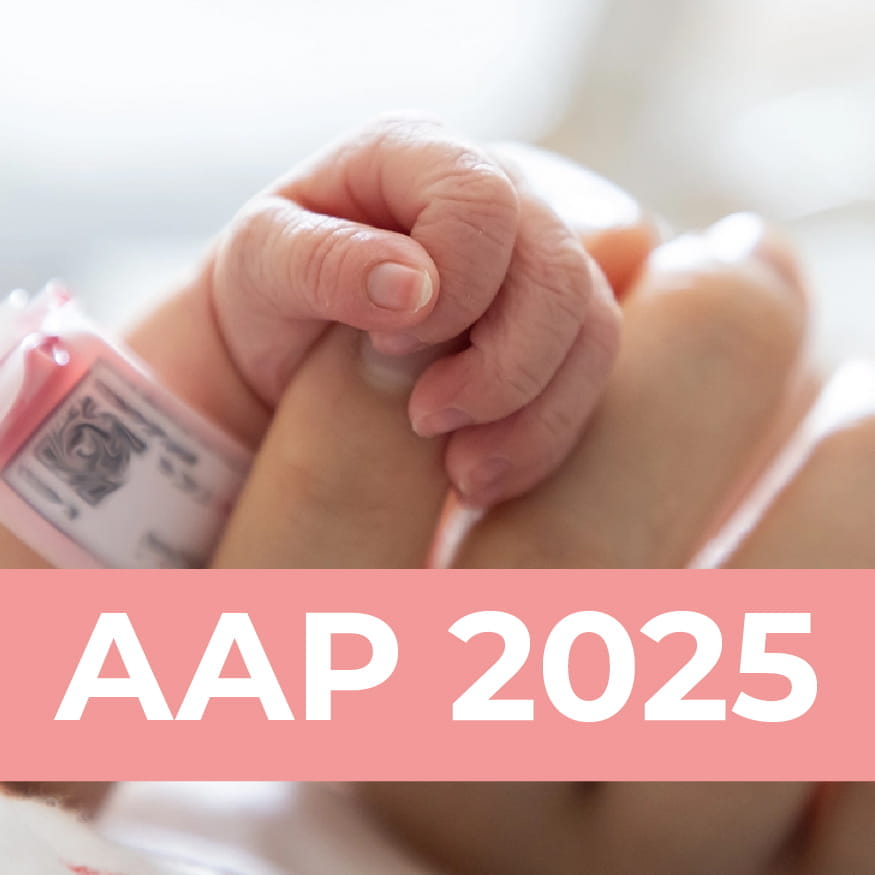AAP 2025: Highlights from Day 4
Screening for Asthma and Related Environmental Risks in a High-Risk Pediatric Populations: A Descriptive Analysis of Universal Screening
Presenter: Karen G. Ganacias
The Kids Medical Mobile Clinic (KMMC) integrated an Asthma Risk and Control Screen (ARCS) into routine well-child visits, targeting children aged 2 years and older in an urban population with high asthma prevalence. Of 650 children screened, 17.7% had a prior asthma diagnosis, while 35% without previous diagnosis reported asthma risk factors. Among these, 24% were newly diagnosed with asthma, representing 7.8% of all screened. Home environment risks were reported by 38% of children with known asthma and 52% of those with symptoms but no diagnosis. This underscores the need for routine symptom screening and environmental interventions.
Efficacy and Safety of a Novel Oral Iron (Ferric Maltol) in Children and Adolescents; A Randomized, Multicenter, Open-Label, Active Comparator Study
Presenter: David Gass
In a 12-week open-label study, 61 children aged 2–17 years with iron deficiency anemia were randomized equally to oral ferric maltol or ferrous sulfate. Both groups showed clinically significant Hb increases at Week 12 (12.5 g/L ferric maltol, 11.5 g/L ferrous sulfate). Mild/moderate AEs occurred in 29% (ferric maltol) and 30% (ferrous sulfate), with more drug-related AEs in ferrous sulfate. Iron increase at Week 12 was higher in ferric maltol (5.77 vs. 3.64 µmol/L). TSAT changes were similar, while ferritin rose more with ferrous sulfate.
Ferric maltol was better rated for taste, smell, swallowability, and ease of intake, with fewer negative taste reports (6.9% vs. 34.6%). Ferric maltol improved Hb and iron stores with better tolerability than ferrous sulfate.
Analysis of the Effectiveness of CRISPR and Gene Therapy in Duchenne Muscular Dystrophy
Presenter: Gayatri Elumalai
Data from recent clinical trials using CRISPR/Cas9 for Duchenne Muscular Dystrophy (DMD) were analyzed, focusing on dystrophin restoration, functional improvements, and adverse effects. Despite the large dystrophin gene size limiting treatment, targeting smaller microdystrophins showed promise. Adeno-associated viral (AAV) vector delivery, while effective in preclinical and early clinical trials with up to 50% dystrophin restoration, elicited a 30% immune response causing acute respiratory distress syndrome and mild cardiac distress. Immune reactions, delivery challenges, and long-term effects remain barriers to wider use. Future efforts must optimize delivery, enhance gene-editing precision, and develop immunomodulation.
Pharmaceutical Involvement in Pediatric Drug Trials: A Review of Industry-Sponsored Research and Ethical Considerations
Presenter: Maram Badran
A comprehensive review of 4,327 industry-sponsored pediatric clinical trials. Industry sponsorship accounted for 68% of Phase III pediatric drug trials, concentrated mainly in oncology (32%), endocrinology (18%), and infectious diseases (15%). These trials demonstrated higher methodological quality (mean Jadad score 4.1 vs. 3.2), but revealed geographic bias with 78% conducted in high-income countries and age bias with only 12% including neonates. Ethical concerns were identified in 28% of trials, including excessive placebo use despite existing treatments (19%), delayed publication of negative results (median 32 vs. 18 months in academia), and focus on blockbuster drug extensions over novel pediatric formulations. Positive trends included increased use of independent data monitoring committees (42% to 68%) and improved pediatric safety reporting (89%).
Novel Smartphone-Based Screening Tool for Absence Seizures in Pediatric Settings: A Comparative Study with Video EEG
Presenter: Rachel Kuperman
In a study with 46 participants using the Eysz HV Recorder during EEG observation, three neurologists reviewed EEGs for seizures, while three epileptologists independently reviewed video recordings from the Eysz HV app for seizure detection. A total of 25 seizures were identified in 12 participants, with 37 participants having no seizures. Seizure presence was determined by majority agreement among EEG reviewers.
Video reviewers demonstrated a sensitivity of 96.3% (two reviewers achieved 100%) for seizures lasting ≥7 seconds, but only 44.4% sensitivity for seizures <7 seconds. Mean specificity for video reviewers was 90.1%. Agreement rates between EEG reviewers averaged 94.4%, comparable to 83.3% agreement between Eysz HV reviewers and EEG reviewers. These findings support Eysz HV as an accurate screening tool for childhood absence epilepsy.
RSV Immunoprophylaxis in Infants and Breakthrough Infection: Clinical Impact and Viral Features
Presenter: Sergio Monares Ortiz
Nasopharyngeal swabs were collected from 216 RSV-infected children under 2 years. Of these, 19 (9%) had active RSV immunoprophylaxis, and 197 (91%) had remote or no immunoprophylaxis. Higher PCR cycle threshold (Ct) values were observed in infants with active immunoprophylaxis compared to those with remote/prior year or no immunoprophylaxis (p = 0.03). RSV subtype A was the most frequent viral subtype in both groups. Hospitalization rates among infants seeking care were comparable between immunized and non-immunized cohorts. Respiratory symptoms and antibiotic use were lower in immunized infants. Further viral genome and immunoprofiling analyses are ongoing.
The HDM SLIT-Tablet Improves QoL and Reduces Clinical Symptoms in Children (5-11 Years) With House Dust Mite Allergic Rhinitis/Rhinoconjunctivitis – Results from a Global Phase III Clinical Trial
Presenter: Dawn Hezel
The MT-12/MATIC trial was a double-blind, placebo-controlled phase III study including 1,458 children aged 5–11 years randomized 1:1 to receive the HDM SLIT-tablet (12 SQ-HDM) or placebo for about one year. The HDM SLIT-tablet showed a 16.6% improvement in the pediatric rhinoconjunctivitis quality of life questionnaire (PRQLQ) score over placebo (95% CI 8.8 to 24.0, p < 0.0001). Rhinitis daily symptom scores were reduced by 22.2% (p < 0.0001). Reductions in individual symptoms ranged from 22.2% to 28.3% (all p < 0.0001). Treatment-related adverse event discontinuations were 1.8% for HDM SLIT and 1.0% for placebo. The tablet was safe, well tolerated, and clinically effective in improving quality of life and reducing symptoms.
Gut Instincts: Understanding Early-Life Gastroenteritis and Its Epidemiologic Impact on Pediatric Functional GI Disorders
Presenter: Christina A. Stirwalt
A retrospective cohort study using the TriNetX network analyzed 15,178 propensity score-matched pediatric patients with early-life acute gastroenteritis caused by viral or bacterial pathogens between ages 0–3. Exclusions included prior FGIDs, family GI history, congenital anomalies, and celiac disease. The bacterial gastroenteritis cohort showed significantly higher risks of functional gastrointestinal disorders (FGIDs) from ages 3 to 18 compared to the viral cohort. Dyspepsia occurred in 1.118% vs. 0.45% (RR=0.402, p<0.0001), IBS showed similar risk elevation (RR=0.213, p<0.0001), and generalized abdominal pain increased (RR=0.622, p<0.0001). Findings suggest bacterial infections provoke stronger immune responses causing dysbiosis, underscoring the importance of targeted treatment and prevention to reduce long-term GI sequelae.
Rise in Autism Spectrum Disorder Diagnoses: Analysis of Pre-pandemic and Pandemic Periods
Presenter: Srichand Mulakalapalli
A retrospective analysis was conducted on new autism spectrum disorder (ASD) diagnoses from electronic medical records of two private clinics between January 2017–December 2019 (pre-pandemic) and January 2021–December 2023 (pandemic). Sixteen ICD-10 ASD codes were included, excluding patients with prior ASD diagnosis. A total of 537 patients were studied: 182 from Clinic I and 355 from Clinic II. Clinic I diagnoses increased significantly from 63 pre-pandemic to 119 during the pandemic (χ²=17.23; p=0.000033). Clinic II diagnoses rose from 149 to 206 (χ²=9.15; p=0.00248). The increase suggests pandemic-related factors such as lockdowns, heightened parental observation, and healthcare disruptions contributed to higher ASD identification.
American Academy of Paediatrics National Conference & Exhibition 2025 (AAP 2025), 26-30 September 2025, Denver


